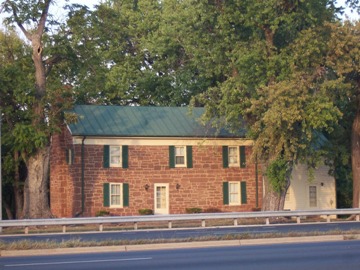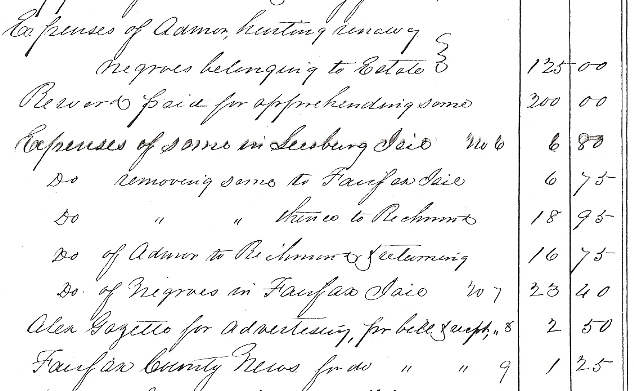| Unsuccessful Bid for Freedom: Plight of the Rileys |
|
by Debbie Robison February 8, 2008 |
|
During the night of Sunday,
December 31, 1854, four slaves, Trolious Riley, Henry Riley, Douglas Riley, and
a man named Vincent, escaped from 
The four men were enslaved by the
Stuart family who owned Chantilly farm, located in Likely Overseer's House at One Time Charles Calvert Stuart’s son, Sholto Turberville Stuart, was administrator of his father’s estate and ran the farm for his father’s widow, Cornelia Lee Turberville Stuart.[3] The farm raised cows, pigs, and sheep; and grew wheat, oats, and straw. Enslaved individuals likely used plows, harrows, and cultivators to farm the fields, and sheep sheers and spinning wheels to make woolen goods. The Stuarts also raised funds by hiring out their slaves to others.[4] On January 8, 1855, Sholto T.
Stuart placed an advertisement in the Alexandria
Gazette offering a reward for the apprehension
and securing of the runaway slaves. One hundred dollars for each man was
offered if they were captured out of state or fifty dollars each if they were
captured in Sholto Stuart could not fathom
why the men would seek their freedom. He noted that they left without any known
cause, and that two of the men were lately married, and left their wives with
an infant each.[6] Though
their individual reasons for escaping are unknown, it is possible that they
were aware that as slaves they would eventually be distributed among the Stuart
heirs. Or they may have feared that they would be sent south to 
Estate account entries in 1855 showing expenses for capturing runaway slaves. Stuart did not rely solely on the
reward offered to others for the return of the men. He paid himself $125.00 out
of the estate funds for hunting runaway
Negroes belonging to [the] Estate.[9]
The Alexandria Gazette reported on
January 15 1855, that Stuart succeeded in capturing the runaways at the Point
of Rocks.[10] Two
hundred dollars in reward money was paid for apprehending the Rileys and
Vincent. The men were taken to the Leesburg jail before being conveyed to the The men did not go back to [N.B. Trolious was also spelled Troilus.] [1] S. T.
Stuart, “$400 Reward,” [2] Fairfax County Superior Court Book 1:143, Charles Calvert Stuart Inventory, November 1, 1846. [3] [4] Fairfax County Superior Court Book 1:143, Charles Calvert Stuart Inventory, November 1, 1846. [5] S. T.
Stuart, “$400 Reward,” [6] S. T.
Stuart, “$400 Reward,” [7] [8] [9] Ibid. [10] [11] [12] [13] Ibid. |
